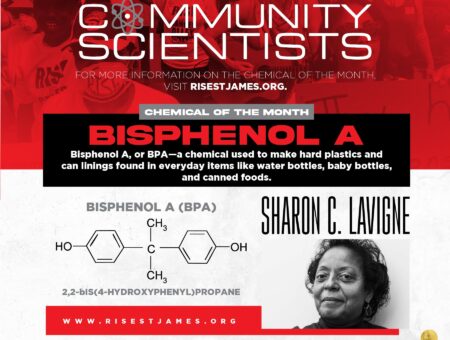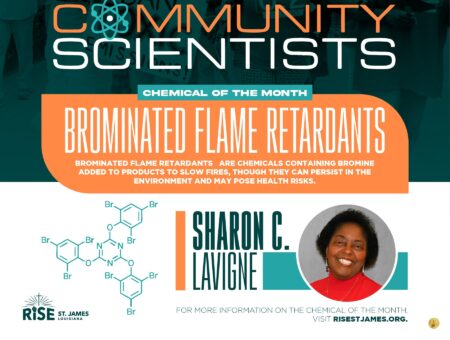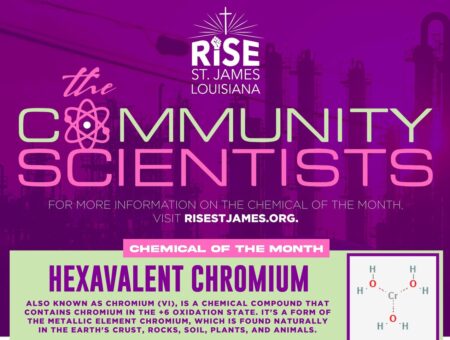Chemical of the Month
Chemical of the Month
How much do you know about the life-threatening chemicals impacting Cancer Alley and throughout the state of Louisiana? Test your knowledge and learn more.

Test your knowledge
-

Bisphenol A, or BPA
A program of RISE St. James Louisiana and The Community Scientist (TCS) Research Team, led by Caitlion O. Hunter, Esq., Research & Policy Director at RISE St. James; Founder & CEO Sharon C. Lavigne; Chief Operating Officer Shamell Lavigne; Executive Marketing and Environmental Communications Consultant Gary C. Watson, Jr.; and…
-

Bisphenol A, or BPA
A chemical used to make hard plastics and can linings found in everyday items like water bottles, baby bottles, and canned foods.
A program of RISE St. James Louisiana and The Community Scientist (TCS) Research Team, led by Caitlion O. Hunter, Esq., Research & Policy Director at RISE St. James; Founder & CEO Sharon C. Lavigne; Chief Operating Officer Shamell Lavigne; Executive Marketing and Environmental Communications Consultant Gary C. Watson, Jr.; and anthropologist Tim Schütz, PhD (University of California, Irvine), and supported by dedicated community members, volunteers, and scientists.
At the Community Scientists, we rely on sound research to bring you the information about chemicals and pollution. We use peer-reviewed studies and information from government sources like the Environmental Protection Agency (EPA) and the National Institutes of Health to give you the facts you need to understand pollution in your home and community. However, not all science is reputable. For example, Philip Morris created and funded a group called “Foundation for a Smoke-Free World”, now known as “Global Action to End Smoking”, to fund studies in support of nicotine vapes. The American Chemistry Council, funded by petrochemical companies, has a factsheet on ethylene oxide that fails to mention the risks of leukemia and breast cancer caused by ethylene oxide exposure. The American Council on Science and Health, although it presents itself as a nonprofit acting “to inform the public and policymakers of good science”, is largely funded by large corporations such as Coca-Cola, Monsanto, McDonalds, Chevron, and Big Tobacco. It has put out statements in support of fracking, pesticide use, ultraprocessed foods, and the use of bisphenol A, also known as BPA. It should be no surprise that another corporate sponsor is Dow, once one of the world’s largest producers of BPA.
Although major consumer campaigns around eliminating BPA in plastics began nearly 15 years ago, bisphenols are still widely used today. Most people are exposed to BPA from food and beverage containers, or by microwaving food in plastic containers made with BPA. Bisphenols are derived from fossil fuel, and are used in the production of polycarbonate plastic, the hard, clear plastic used for some shatterproof drinking cups, coffee machines, and eyeglass lenses. BPA is also used to make epoxy resins like can linings. Many canned beverages like soda and beer are packaged in cans lined with BPA or other bisphenols. Bisphenol A is just one of a class of at least 50 other bisphenols that are used to make rigid, strong, translucent plastic. Although BPA is the best studied bisphenol, the current trend of advertising “BPA Free” is pushing manufacturers to use lesser-studied bisphenols with unknown health effects in their products. For example, receipt paper was made with extremely high amounts of BPA for decades, but instead of removing bisphenols from the paper entirely, the paper is now often made with the similar bisphenol S (BPS).
BPA interacts with estrogen receptors in the body, and can also affect the thyroid. Children who are exposed to BPA during early life can develop behavior issues. Exposure to BPA while pregnant can lead to an increased risk of asthma for the child. A large study of Americans in 2008 found that more than 90% of participants had detectable levels of BPA in their urine, with the highest levels seen in children. Although BPA is eliminated from the body quickly, the hormonal changes it causes can last a lifetime. EPA data from 2003-2016 shows that levels of BPA in the urine of American children and adults have dramatically decreased over this time period, meaning that people are being exposed to less BPA. However, recent studies suggest that levels of BPS and other bisphenols are increasing, and that these “safer” bisphenols may actually be more dangerous to human health than BPA.
Beginning in the 1960s, BPA was used in the first plastic baby bottles (seen as a safer alternative to glass), the linings of formula cans, and other products intended for children’s use. By the late 1990s, research was showing that BPA negatively impacted multiple organs and development of puberty. In response, manufacturers of BPA paid scientists to conduct unscrupulous studies, pumped money into PR campaigns that cited these bad studies, and tried to find a pregnant woman to act as a spokesperson about the safety of BPA. In 2008, the Food and Drug Administration (FDA) first released guidance about potential concerns with BPA in such products, and an FDA ban on BPA in bottles, formula cans, and sippy cups went into effect in 2012. Today, the FDA still allows BPA in all other food and drink packaging, but it is banned in several states and the EU.
Rather than take steps to protect public health in the face of evidence of BPA’s dangerous effects on the human body, companies that made and used BPA funded bad studies and hired good PR. This is why independent science on petrochemicals and pollution, conducted without funding or interference by the polluting industry, is so critical. The Community Scientists and RISE St. James Louisiana want to call attention to the efforts by Tulane University to silence the research of Community Scientists member Dr. Kim Terrell, who has investigated the link between pollution and low birth rates in Cancer Alley, among other critical research. Dr. Terrell’s research challenges the polluting industry-sponsored narrative that petrochemical facilities are safe and provide jobs, and shines a light into a dark truth: that pollution from the petrochemical industry harms human health.
-
 Question 1 of 2Correct! Did You Know...
Question 1 of 2Correct! Did You Know... -
 Question 2 of 2Correct! Did You Know...
Question 2 of 2Correct! Did You Know... -
HOW TO REDUCE YOUR EXPOSURE TO BISPHENOLS
- The number one way to reduce your exposure to BPA and other bisphenols is to not microwave food in plastic containers of any kind or put hot drinks into plastic cups. Microwaving plastic releases BPA, phthalates, and other plastic additives into food or drinks. Even plastics marked as “microwave safe”, like take-out containers, should never be microwaved. Transfer any food purchased in plastic to a china, pottery, or other plate before microwaving.
- BPA and other plastic additives like phthalates migrate more easily into fatty foods like dairy, oil, or meat. Do not use plastic to store or serve these foods. If possible, buy oils in glass bottles instead of plastic.
- Choose frozen or fresh foods instead of canned food, which often contain bisphenols in the can lining. If you use canned food, thoroughly rinsing the food can help to wash away some amount of bisphenols.
- Cashiers have some of the highest levels of bisphenol exposure due to their handling of receipt paper. If your job prints receipts, investigate what kind of paper is being used, and wear gloves if possible to avoid skin contact with paper containing bisphenols.
- There is no way to know if a plastic contains BPA or other bisphenols, but plastics marked with a 3 or 7 probably do. Keep plastics away from children and avoid plastic toys, especially older ones made before awareness of BPA’s harmful properties was known.
-
Support our efforts to clean up our community
You can help increase the amount of outreach we can do. Any amount helps.
Donate Today
-
-

Brominated flame retardants (BFRs)
A program of RISE St. James Louisiana and The Community Scientist (TCS) Research Team, led by Caitlion O. Hunter, Esq., Research & Policy Director at RISE St. James; Founder & CEO Sharon C. Lavigne; Chief Operating Officer Shamell Lavigne; Executive Marketing and Environmental Communications Consultant Gary C. Watson, Jr.; and…
-

Brominated Flame Retardants
Compounds that reduce the flammability of products
A program of RISE St. James Louisiana and The Community Scientist (TCS) Research Team, led by Caitlion O. Hunter, Esq., Research & Policy Director at RISE St. James; Founder & CEO Sharon C. Lavigne; Chief Operating Officer Shamell Lavigne; Executive Marketing and Environmental Communications Consultant Gary C. Watson, Jr.; and anthropologist Tim Schütz, PhD (University of California, Irvine), and supported by dedicated community members, volunteers, and scientists.
Brominated Flame Retardants
Children born today may find it impossible to believe that cigarettes were once smoked on airplanes (banned in 2000), in post offices and courts (banned in 1997), and even in hospitals (banned in 1994). From a height of 42.6% of adults smoking cigarettes in 1965 to just 11.6% in 2022, a world in which smoke, flame, butts, and ash are a constant part of everyday life is unimaginable. The tobacco industry fought tooth and nail to prevent any regulation of cigarettes or smoking, but after decades of activism, health studies, lawsuits, and campaigns, nearly everyone can breathe air free from smoke.
However, the impact of indoor smoking continues today in less known ways, such as the continued use of flame retardant fabrics and materials. Cigarette design and additives in the 1970s allowed them to burn for as long as 20 minutes when set down, and up to half of all deaths by fire were caused by these smouldering cigarettes catching fire to furniture and clothing. (Cigarettes today are required to be self-extinguishing to prevent fires.) In response to burns and deaths caused by cigarettes igniting synthetic materials, new regulations were made in 1972 that required mattresses, furniture, and children’s sleepwear to burn more slowly. To reduce flammability in childrens’ pajamas, industry complied by adding brominated flame retardants (BFR) to fabrics, often in such high amounts as to make up 20% of the weight of the fabric. But just five years later, researchers found that the main BFR used in children’s pajamas, known as “TRIS”, was carcinogenic and was being absorbed through the children’s skin.
Flame retardants work either by generating non-combustible gases to eliminate oxygen and extinguish the flame, or by using chemical processes to decrease a material’s surface temperature lower than the burning point to stop fires from spreading. They can be added to plastic, foams, and other synthetic materials during the manufacturing process. Depending on the flame retardant used, they can either bind permanently with the plastic, or can be loosely mixed in as a plasticizer or filler that can later bleed or leach out. A class of chemicals called brominated flame retardants (BFR) are commonly added to plastics that are used to make foam, electronics, coatings for wires and cables, fabrics, and carpets. Health effects vary among this wide class of chemicals, but include endocrine (hormone) disruption, thyroid dysfunction, damage to the immune and reproductive systems, neurodevelopmental disorders, and cancer.
Flammable materials used in the home include polyurethane foam in mattresses and cushions and polyester in upholstery and clothing. Polybrominated diphenyl ethers (PBDEs) is a common type of BFR found in these materials, among others. When polyurethane foam is exposed to open flame, it quickly ignites, and releases both carbon monoxide and hydrogen cyanide. If high concentrations of these gases are inhaled, they can cause serious health problems or even death. Polyester in clothing melts under high heat and can fuse to skin, and polyester-cotton blends are very flammable. Even though carcinogenic TRIS was banned in 1977, it and other BFRs do not break down in the environment, and TRIS was present in the dust of 75% of homes in a study conducted 35 years after the ban. It was not until 1998 that the regulations were amended to allow kids’ pajamas to be sold without flame retardants. People continuing to use old furniture and clothing treated with BFRs are also still being exposed to these chemicals.
The Fire Safety Research Institute conducts regular comparison studies of the time it takes for a small fire to reach a “flashover” point, or where high temperatures cause fire to spread rapidly, in two similar rooms. The first is furnished with natural materials like cotton padded sofa, solid wood tables, and hardwood flooring, the other with synthetic materials like polyester covered polyurethane filled sofa, engineered wood table, and polyolefin carpet. In a 2020 test, the naturally furnished room took more than 30 minutes to reach flashover point; for the synthetic room, it took under four minutes. Even with flame retardants in use, synthetic materials burn hotter, faster, and release more hazardous chemicals in their smoke.
We as a country took action to prevent children from being exposed to second-hand smoke —when will kids of the future look back and be unable to comprehend just how many plastics used to be in our homes, our water, our food, and even our bodies? Just like Big Tobacco, plastic manufacturers and users are fighting against regulations that would require them to take responsibility for single-use plastic trash, pay to clean up contaminated water, and remove harmful plastic additives. It took only five years for researchers to realize that the “miracle” BFR used in kids’ pajamas was carcinogenic, but another twenty years for this class of chemicals to be phased out of clothing. We have enough evidence today that plastic, its additives, and its manufacture are harmful to human health—we can’t wait another twenty years.
HOW TO REDUCE YOUR EXPOSURE TO BROMINATED FLAME RETARDANTS:
Beginning in the 1970s, most upholstered furniture began to use BFR in foam and fabrics. It was not until 2015 that some manufacturers began to phase them out. It is probably not worth keeping an old sofa around due to the presence of BFR and other harmful materials. Check this list of furniture makers who do not use BFR in their products: https://www.ewg.org/news-insights/news/you-can-find-hundreds-couches-without-toxic-flame-retardants
Look for kids’ pajamas with a bright yellow tag (required by law) that state that they are free from BFR. Older children’s pajamas likely contain BFR and should not be used, even if they have been washed many times.
A 2024 study found that black plastic cooking utensils were contaminated with BFR, likely from electronic waste making its way into the supply chain. Use wooden, bamboo, or stainless steel utensils to cook with instead.
Choose natural materials to furnish your home. Not only will this improve fire safety, but will prevent you from exposure to BFR and off-gassing from synthetic materials. -
 Question 1 of 2Correct! Did You Know...
Question 1 of 2Correct! Did You Know... -
 Question 2 of 2Correct! Did You Know...
Question 2 of 2Correct! Did You Know... -
HOW TO REDUCE YOUR EXPOSURE TO BROMINATED FLAME RETARDANTS:
-
Support our efforts to clean up our community
You can help increase the amount of outreach we can do. Any amount helps.
Donate Today
-
-

Hexavalent chromium
It’s a highly toxic form of the element chromium that causes serious harm too human health if inhaled or consumed through drinking water.
-

Introduction to Hexavalent Chromium
It’s a highly toxic form of the element chromium that causes serious harm too human health if inhaled or consumed through drinking water.
-
 Question 1 of 2Correct! Did You Know...
Question 1 of 2Correct! Did You Know...- Consuming water polluted with Cr(VI) through polluted water is toxic and carcinogenic to the GI tract, and there is evidence that it is also harmful to the immune system and male reproductive system.
- Acute, or short-term, exposure to Cr(VI) through the air can cause irritation to the nose, coughing or wheezing, rashes, or eye irritation.
- Chronic, or long-term, exposure through the lungs is linked with respiratory issues, ulcers, and lung, nasal, and sinus cancers.
- Workers who are exposed to airborne Cr(VI) on the job can develop nasal septum perforations, impaired lung function, and other respiratory effects.
- Long term exposure through the skin can also lead to an allergic reaction which causes swelling and an itchy, crusty rash every time the skin comes in contact with Cr(VI).
-
 Question 2 of 2Correct! Did You Know...
Question 2 of 2Correct! Did You Know...A 2018 study of tattoo inks found that 90% of the inks tested contained hexavalent chromium in amounts above the safe level allowed in the European Union. If you are planning a tattoo, ask your artist about the safety testing that their brand of inks go through.
-
How to Reduce the Need for Hexavalent Chromium
Choose clothes that are dyed with plant-based materials.
Artificial dye plants use heavy metals like chromium to produce pigments, which then pollute our air and water. The dye production is hazardous to the workers, too.
Ask about the ink in your tattoo
A 2018 study of tattoo inks found that 90% of the inks tested contained hexavalent chromium in amounts above the safe level allowed in the European Union. If you are planning a tattoo, ask your artist about the safety testing that their brand of inks go through. For more information, check out https://earthjustice.org/article/what-i-wish-id-known-before-getting-a-tattoo
Using chrome plating in your business?
If your business uses chrome plating, look into the new thermal spray and vacuum depositing methods as alternatives.
-
Join the fight against petrochemical expansion in Cancer Alley

Make a Donation
Your donation helps us keep fighting. Your support inspires us to fight harder.
Donate Today
Learn more about Hexavalent Chromium
Keep reading for more details and how you can avoid it. It’s found naturally in the earth’s crust, rocks, soil, plants, and animals.
Hexavalent Chromium
-
-

Ethylene Oxide
It is colorless, odorless, and has no residue or distinct feeling when inhaled. But it is one of the single most dangerous substances produced in Louisiana today.
-

Ethylene Oxide
A flammable toxic gas used as an intermediate and fumigant.
It is colorless, odorless, and has no residue or distinct feeling when inhaled. But it is one of the single most dangerous substances produced in Louisiana today.
-
 Question 1 of 2Correct! Did You Know...
Question 1 of 2Correct! Did You Know...It took the EPA until 2016 to acknowledge the cancer risk and until 2018 to create new restrictions on emissions. In the meantime, facilities in St. Gabriel, St. John the Baptist, and St. Charles parishes were emitting tons of ethylene oxide each year. The EPA only reached out to warn affected Gulf South communities, most of which are majority Black and low-income, last summer. There is no excuse for these decades of silence, and the countless lives affected by the emissions.
-
 Question 2 of 2Correct! Did You Know...
Question 2 of 2Correct! Did You Know...Ethylene oxide isn’t necessary to power our world, and instead of building more facilities to produce it, we should invest in existing, less harmful alternatives. Its common uses include making polyester fabrics, single use plastics, and antifreeze.
But polyester fabrics shed microplastics every time they are worn or washed, and these plastic pieces make their way into our drinking water, our rivers and oceans, and even the air we breathe. Research is ongoing on the effect of microplastics on human health, but microplastics have been shown to interfere greatly with fish and other sea creatures who eat it. In a cruel twist, those who drink bottled water- often out of necessity, since toxic industries have polluted the local water supply- drink about 25 times more microplastics than those whose communities can provide clean tap water.
Speaking of bottled water, ethylene oxide is also a precursor to single use plastics, including those used to make soda and water bottles. We need an investment in safe tap water for everyone, not more microplastic-shedding single use containers.
-
How to reduce the need for Ethylene Oxide
Fill your closet with clothing made from natural fibers like hemp, linen, and cotton instead of polyester.
If buying secondhand, which results in less waste, emissions, and resources overall, avoid used polyester if possible. However, polyester-cotton blends shed less than pure polyester.
Shift away from single-use plastic bottles.
Consider installing a reverse osmosis or other filtration system in your house, if you do not trust the tap water. While still using plastic components, they do not shed microplastics and result in far less plastic waste than using bottles. There are several pitcher-style products that have been proven to remove microplastics from tap water.
Ask your mechanic or auto supply store to install warning signs
Ask your mechanic or auto supply store to install warning signs about the toxicity of ethylene glycol antifreeze, and choose propylene glycol instead. In Southern climates, there is no benefit to a regular driver using ethylene glycol.
-

Support our efforts to clean up our community
You can help increase the amount of outreach we can do. Any amount helps.
Donate Today
-
